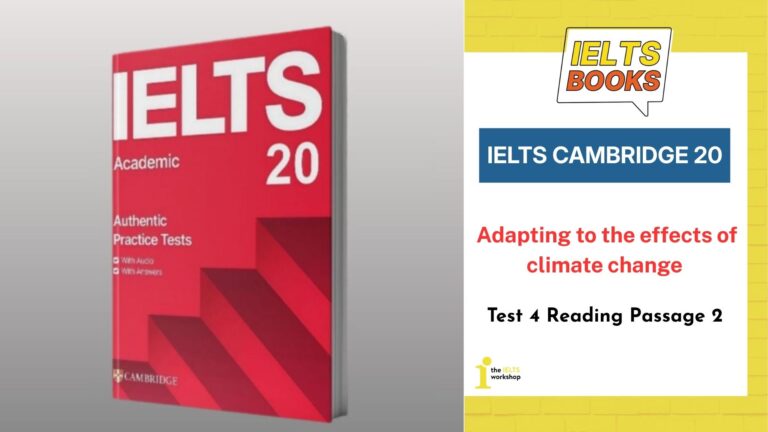Dạng bài Reading trong IELTS đòi hỏi vô vàn kĩ năng, đem đến bao thách thức đối với người học. Để làm tốt dạng bài này đòi hỏi kiến thức, kĩ năng và nguồn tài liệu uy tín. Bài viết cung cấp đáp án, phân tích chi tiết IELTS Cambridge 20 Test 4 Reading Passage 2: Adapting to the effects of climate change.
Đáp án IELTS Cambridge 20 Test 4 Reading Passage 2
| Câu hỏi | Đáp án |
|---|---|
| 14 | D |
| 15 | A |
| 16 | D |
| 17 | F |
| 18 | pumps |
| 19 | dams |
| 20 | float |
| 21 | crops |
| 22 | trees |
| 23 | B – Susanna Tol |
| 24 | E – Greg Spotts |
| 25 | A – Yanira Pineda |
| 26 | C – Elizabeth English |
Phân tích chi tiết IELTS Cambridge 20 Test 4 Reading Passage 2
Câu 14: Đáp án D
Câu hỏi: How a type of plant functions as a natural protection for coastlines.
Dịch: Loại cây nào hoạt động như một lớp bảo vệ tự nhiên cho bờ biển.
Vị trí: Đoạn D
Transcript: “There have been many attempts to restore the island’s coastal mangroves: ecosystems of trees and shrubs that help defend coastal areas by trapping sediment in their net-like root systems, elevating the sea bed and dampening the energy of waves and tidal currents.”
Phân tích:
- Từ khóa: plant, natural protection, coastlines.
- Mangroves = cây đước → giữ phù sa, nâng đáy biển, giảm năng lượng sóng.
- Đây chính là vai trò bảo vệ tự nhiên → chọn D.
Câu 15: Đáp án A
Câu hỏi: A prediction about how long it could take to stop noticing the effects of climate change.
Dịch: Một dự đoán về thời gian cần để ngừng nhận thấy tác động của biến đổi khí hậu.
Vị trí: Đoạn A
Transcript: “Even if we stopped all CO2 emissions tomorrow, we would continue to see the impact… scientists forecasting that global warming would continue for around 40 years.”
Phân tích:
- Từ khóa: prediction, how long, effects of climate change.
- Có con số “40 years” → dự đoán thời gian → chọn A.
Câu 16: Đáp án D
Câu hỏi (EN): A reference to the fact that a solution is particularly cost-effective.
Dịch: Đề cập đến việc một giải pháp đặc biệt tiết kiệm chi phí.
Vị trí: Đoạn D
Transcript: “…it’s much cheaper than permanently elevating houses. English explains that it costs about a third of what it would cost to completely replace a building’s foundations.”
Phân tích:
- Từ khóa: cost-effective, cheaper, solution.
- Công nghệ nhà nổi rẻ hơn ⅓ so với giải pháp khác → chọn D.
Câu 17: Đáp án F
Câu hỏi: A mention of a technology used to locate areas most in need of intervention.
Dịch: Đề cập đến một công nghệ được sử dụng để xác định khu vực cần can thiệp nhất.
Vị trí: Đoạn F
Transcript: “Using a Geographic Information System data mapping tool, the programme identified streets with low tree canopy cover…”
Phân tích:
- Từ khóa: technology, locate areas, intervention.
- Công nghệ GIS dùng để tìm nơi cần trồng cây → chọn F.
Câu 18: Đáp án pumps
Câu hỏi: The stormwater-management programme in Miami Beach has involved the installation of efficient _______.
Dịch: Chương trình quản lý nước mưa ở Miami Beach đã bao gồm việc lắp đặt _______ hiệu quả.
Vị trí: Đoạn B
Transcript: “…the city has set up new pumps that can remove up to 75,000 litres of water per minute.”
Phân tích:
- Từ khóa: installation, efficient, stormwater-management.
- Đoạn văn nói rõ về việc lắp đặt “new pumps” → đáp án: pumps.
Câu 19: Đáp án dams
Câu hỏi: The construction of _______ was the first stage of a project to ensure the success of mangroves in Indonesia.
Dịch: Việc xây dựng _______ là giai đoạn đầu tiên của một dự án nhằm đảm bảo sự thành công của cây đước ở Indonesia.
Vị trí: Đoạn C
Transcript: “…Wetlands International started out with a different approach, building semi-permeable dams, made from bamboo poles and brushwood…”
Phân tích:
- Từ khóa: construction, first stage, success of mangroves.
- Dự án bắt đầu bằng việc xây đập → dams.
Câu 20: Đáp án float
Câu hỏi: As a response to rising floodwaters in the Mekong Delta, a not-for-profit organisation has been building houses that can _______.
Dịch: Để đối phó với lũ dâng cao ở Đồng bằng sông Cửu Long, một tổ chức phi lợi nhuận đã xây dựng các ngôi nhà có thể _______.
Vị trí: Đoạn D
Transcript: “…Homes in this part of Vietnam are traditionally built on stilts but these ones had been built to float.”
Phân tích:
- Từ khóa: houses, can, rising floodwaters.
- Nhà được thiết kế để “float” (nổi) → đáp án: float.
Câu 21: Đáp án crops
Câu hỏi: Rising sea levels in Bangladesh have made it necessary to introduce various _______ that are suitable for areas of high salt content.
Dịch: Mực nước biển dâng ở Bangladesh đã khiến cần phải giới thiệu nhiều _______ phù hợp với khu vực có độ mặn cao.
Vị trí: Đoạn E
Transcript: “…helping communities adapt to salt-affected soils… to start cultivating naturally salt-tolerant crops.”
Phân tích:
- Từ khóa: high salt content, introduce, suitable.
- Loại thích hợp là “salt-tolerant crops” → đáp án: crops.
Câu 22: Đáp án trees
Câu hỏi: A project in LA has increased the number of _______ on the city’s streets.
Dịch: Một dự án ở LA đã tăng số lượng _______ trên các con phố của thành phố.
Vị trí: Đoạn F
Transcript: “…pilot projects, which include the planting of trees and the installation of a ‘cool pavement’ system…”
Phân tích:
- Từ khóa: increased the number of, streets.
- “Planting of trees” → chỉ cây mới có thể tăng về số lượng → đáp án: trees.
Câu 23: Đáp án B – Susanna Tol
Câu hỏi: It is essential to adopt strategies which involve and help residents of the region.
Dịch: Cần thiết áp dụng các chiến lược có sự tham gia và hỗ trợ người dân trong khu vực.
Vị trí: Đoạn C
Transcript: “…For long-term success, it’s critical that we transition towards multifunctional approaches that embed natural processes and that engage and benefit communities and local decision-makers.”
Phân tích:
- Từ khóa: strategies, involve residents, help communities.
- Tol nhấn mạnh việc kết hợp cộng đồng → chọn B.
Câu 24: Đáp án E – Greg Spotts
Câu hỏi: Interventions which reduce heat are absolutely vital for our survival in this location.
Dịch: Những biện pháp giảm nhiệt là rất quan trọng cho sự sống còn của chúng ta tại khu vực này.
Vị trí: Đoạn F
Transcript: “‘Urban cooling is literally a matter of life and death for our future in LA,’ says Spotts.”
Phân tích:
- Từ khóa: reduce heat, vital, survival.
- Spotts khẳng định giảm nhiệt là “life and death” → chọn E.
Câu 25: Đáp án A – Yanira Pineda
Câu hỏi: More work will need to be done in future decades to deal with the impact of rising water levels.
Dịch: Sẽ cần nhiều công việc hơn trong các thập kỷ tới để đối phó với tác động của mực nước dâng cao.
Vị trí: Đoạn B
Transcript: “‘We know that in 20, 30, 40 years, we’ll need to go back in there and adjust to the changing environment,’ she says.”
Phân tích:
- Từ khóa: future decades, more work, rising water levels.
- Yanira đề cập cần quay lại sau nhiều năm → chọn A.
Câu 26: Đáp án C – Elizabeth English
Câu hỏi: The number of locations requiring action to adapt to flooding has grown in recent years.
Dịch: Số lượng địa điểm cần hành động để thích ứng với lũ lụt đã tăng trong những năm gần đây.
Vị trí: Đoạn D
Transcript: “…this technology is becoming necessary in places that didn’t previously need it.”
Phân tích: English nói công nghệ nhà nổi ngày càng cần thiết ở nhiều nơi hơn → chọn C.
Từ khóa: number of locations, grown, adapt to flooding.
Bản dịch IELTS Cambridge 20 Test 4 Reading Passage 2
Adapting to the effects of climate change
A. All around the world, nations are already preparing for, and adapting to, climate change and its impacts. Even if we stopped all CO2 emissions tomorrow, we would continue to see the impact of the CO2 already released since industrial times, with scientists forecasting that global warming would continue for around 40 years. In the meantime, ice caps would continue to melt and sea levels rise. Some countries and regions will suffer more extreme impacts from these changes than others. It’s in these places that innovation is thriving.
Trên khắp thế giới, các quốc gia đã bắt đầu chuẩn bị và thích ứng với biến đổi khí hậu cùng những tác động mà nó mang lại. Ngay cả khi chúng ta dừng toàn bộ lượng khí CO₂ phát thải từ ngày mai, những ảnh hưởng từ lượng CO₂ đã thải ra kể từ thời kỳ công nghiệp vẫn sẽ tiếp tục, và các nhà khoa học dự báo hiện tượng nóng lên toàn cầu sẽ kéo dài khoảng 40 năm nữa. Trong thời gian đó, băng ở hai cực vẫn tiếp tục tan và mực nước biển sẽ tiếp tục dâng. Một số quốc gia và khu vực sẽ phải chịu tác động nghiêm trọng hơn những nơi khác, và chính ở những khu vực này, các giải pháp đổi mới đang phát triển mạnh mẽ.
Từ vựng cần nhớ:
| Từ vựng | Phiên âm | Nghĩa |
| adapt | /əˈdæpt/ | thích nghi, điều chỉnh |
| emission | /ɪˈmɪʃn/ | sự phát thải |
| forecast | /ˈfɔːrkæst/ | dự báo |
| thrive | /θraɪv/ | phát triển mạnh |
B. In Miami Beach, Florida, USA, seawater isn’t just breaching the island city’s walls, it’s seeping up through the ground, so the only way to save the city is to lift it up above sea level. Starting in the lowest and most vulnerable neighbourhoods, roads have been raised by as much as 61 centimetres. The elevation work was carried out as part of Miami Beach’s ambitious but much-needed stormwater-management programme. In addition to the road adaptations, the city has set up new pumps that can remove up to 75,000 litres of water per minute. In the face of floods, climate-mitigation strategies have often been overlooked, says Yanira Pineda, a senior sustainability coordinator. She knows that they’re essential and that the job is far from over. ‘We know that in 20, 30, 40 years, we’ll need to go back in there and adjust to the changing environment,’ she says.
Tại Miami Beach, Florida (Mỹ), nước biển không chỉ tràn qua các bức tường bảo vệ của thành phố đảo này mà còn thấm ngược từ dưới lòng đất, vì vậy cách duy nhất để cứu thành phố là nâng nó cao hơn mực nước biển. Bắt đầu từ những khu vực thấp nhất và dễ bị tổn thương nhất, các con đường đã được nâng lên tới 61 cm. Công việc nâng cao này nằm trong chương trình quản lý nước mưa đầy tham vọng nhưng rất cần thiết của Miami Beach. Bên cạnh việc điều chỉnh đường sá, thành phố còn lắp đặt các máy bơm mới có khả năng hút tới 75.000 lít nước mỗi phút. Đối mặt với tình trạng ngập lụt, các chiến lược giảm thiểu tác động của khí hậu thường bị xem nhẹ, Yanira Pineda – điều phối viên bền vững cấp cao – cho biết. Bà hiểu rằng những chiến lược này rất quan trọng và công việc vẫn còn lâu mới kết thúc: “Chúng ta biết rằng trong 20, 30, 40 năm tới, chúng ta sẽ phải quay lại đó để điều chỉnh phù hợp với môi trường đang thay đổi,” bà nói.
Từ vựng cần nhớ:
| Từ vựng | Phiên âm | Nghĩa |
| vulnerable | /ˈvʌlnərəbl/ | dễ bị tổn thương |
| elevation | /ˌelɪˈveɪʃn/ | sự nâng cao |
| pump | /pʌmp/ | máy bơm |
| mitigation | /ˌmɪtɪˈɡeɪʃn/ | sự giảm thiểu |
C. Rotterdam in the Netherlands is one of the lowest cities in Europe, and much of it lies below sea level. The city has invested heavily in climate adaptation, introducing “water plazas,” which double up as both recreational areas and emergency reservoirs. When it rains, the water plazas collect excess rainfall, preventing floods. When it’s dry, people can use them as playgrounds, sports fields, or parks. These multifunctional spaces not only protect the city but also improve urban life.
Rotterdam (Hà Lan) là một trong những thành phố thấp nhất châu Âu, phần lớn diện tích nằm dưới mực nước biển. Thành phố đã đầu tư mạnh mẽ vào việc thích ứng với biến đổi khí hậu, giới thiệu mô hình “quảng trường nước” vừa là khu vui chơi giải trí, vừa là hồ chứa khẩn cấp. Khi trời mưa, các quảng trường này thu gom lượng mưa dư thừa, ngăn ngừa ngập lụt. Khi khô ráo, chúng trở thành sân chơi, sân thể thao hoặc công viên. Những không gian đa chức năng này không chỉ bảo vệ thành phố mà còn nâng cao chất lượng cuộc sống đô thị.
Từ vựng cần nhớ:
| Từ vựng | Phiên âm | Nghĩa |
| reservoir | /ˈrezərvwɑːr/ | hồ chứa |
| excess | /ɪkˈses/ | dư thừa |
| multifunctional | /ˌmʌltiˈfʌŋkʃənl/ | đa chức năng |
| recreational | /ˌrekriˈeɪʃənl/ | giải trí |
D. In Bangladesh, where millions of people live on flood-prone river deltas, floating schools, farms, and even homes have been developed. These structures are built on large wooden boats or floating platforms, rising and falling with the water levels. This innovation means that education, food production, and shelter can continue even during heavy monsoons. Floating agriculture, in particular, allows communities to grow vegetables on rafts made from water hyacinths, ensuring food security despite frequent floods.
Tại Bangladesh, nơi hàng triệu người sinh sống trên các đồng bằng sông dễ bị lũ lụt, các trường học, nông trại và thậm chí cả nhà nổi đã được phát triển. Những công trình này được xây dựng trên những chiếc thuyền gỗ lớn hoặc các nền nổi, có thể lên xuống theo mực nước. Sự sáng tạo này giúp giáo dục, sản xuất lương thực và chỗ ở vẫn được duy trì ngay cả trong những mùa mưa lớn. Đặc biệt, nông nghiệp nổi cho phép cộng đồng trồng rau trên những bè làm từ cây lục bình, đảm bảo an ninh lương thực bất chấp lũ lụt thường xuyên.
Từ vựng cần nhớ:
| Từ vựng | Phiên âm | Nghĩa |
| delta | /ˈdeltə/ | đồng bằng châu thổ |
| monsoon | /ˌmɑːnˈsuːn/ | gió mùa, mùa mưa |
| raft | /ræft/ | bè, mảng |
| hyacinth | /ˈhaɪəsɪnθ/ | cây lục bình |
E. In Vietnam’s Mekong Delta, rising sea levels and saltwater intrusion threaten rice farming, the backbone of the region’s economy. To adapt, many farmers have shifted from rice monoculture to integrated rice–shrimp farming. During the wet season, they grow rice; in the dry season, when saltwater intrudes, they raise shrimp in the same fields. This adaptive method not only increases income but also reduces the risk of complete crop failure due to climate change.
Ở Đồng bằng sông Cửu Long (Việt Nam), mực nước biển dâng và tình trạng xâm nhập mặn đang đe dọa nghề trồng lúa – nền tảng kinh tế của khu vực. Để thích ứng, nhiều nông dân đã chuyển từ canh tác độc canh lúa sang mô hình lúa – tôm kết hợp. Vào mùa mưa, họ trồng lúa; vào mùa khô, khi nước mặn xâm nhập, họ nuôi tôm ngay trên ruộng đó. Phương pháp thích ứng này không chỉ giúp tăng thu nhập mà còn giảm nguy cơ mất trắng mùa vụ do biến đổi khí hậu.
Từ vựng cần nhớ:
| Từ vựng | Phiên âm | Nghĩa |
| intrusion | /ɪnˈtruːʒn/ | sự xâm nhập |
| monoculture | /ˈmɑːnəʊkʌltʃər/ | độc canh (một loại cây) |
| integrated | /ˈɪntɪɡreɪtɪd/ | kết hợp |
| crop failure | /krɑːp ˈfeɪljər/ | mất mùa |
F. In Tokyo, Japan, underground flood chambers known as the “Metropolitan Area Outer Underground Discharge Channel” have been constructed. This massive engineering project includes giant tunnels and storage tanks capable of diverting and storing floodwaters during typhoons or heavy rains. The system protects the city’s 37 million residents from devastating floods, while the enormous underground caverns are sometimes even used as tourist attractions when dry.
Tại Tokyo (Nhật Bản), các hầm chống ngập khổng lồ được gọi là “Kênh thoát nước ngầm ngoại ô” đã được xây dựng. Công trình kỹ thuật quy mô lớn này bao gồm các đường hầm và bể chứa khổng lồ có khả năng dẫn và trữ nước lũ trong mùa bão hoặc mưa lớn. Hệ thống này bảo vệ 37 triệu cư dân của thành phố khỏi những trận lũ tàn phá, và các hang ngầm khổng lồ này đôi khi còn được sử dụng làm điểm tham quan khi khô ráo.
Từ vựng cần nhớ:
| Từ vựng | Phiên âm | Nghĩa |
| chamber | /ˈtʃeɪmbər/ | hầm, buồng |
| divert | /daɪˈvɜːrt/ | chuyển hướng |
| cavern | /ˈkævərn/ | hang động, hang lớn |
| devastating | /ˈdevəsteɪtɪŋ/ | tàn phá, hủy diệt |
G. In Ethiopia, where droughts are becoming more frequent and severe, communities are turning to traditional water-harvesting techniques combined with modern innovations. Small dams, reservoirs, and underground storage systems capture and save rainwater for use during dry periods. Farmers are also adopting drought-resistant crops that can survive with minimal water. These strategies not only provide water security but also help reduce conflicts over scarce resources.
Tại Ethiopia, nơi hạn hán ngày càng xảy ra thường xuyên và nghiêm trọng hơn, các cộng đồng đang quay lại áp dụng các kỹ thuật trữ nước truyền thống kết hợp với đổi mới hiện đại. Các đập nhỏ, hồ chứa và hệ thống lưu trữ ngầm được xây dựng để thu gom và giữ nước mưa dùng trong mùa khô. Nông dân cũng đang áp dụng các giống cây chịu hạn có thể tồn tại với lượng nước tối thiểu. Những chiến lược này không chỉ đảm bảo an ninh nguồn nước mà còn giúp giảm xung đột do khan hiếm tài nguyên.
Từ vựng cần nhớ:
| Từ vựng | Phiên âm | Nghĩa |
| drought | /draʊt/ | hạn hán |
| harvest | /ˈhɑːrvɪst/ | thu hoạch, trữ (nước) |
| drought-resistant | /draʊt rɪˈzɪstənt/ | chịu hạn |
| scarce | /skers/ | khan hiếm |
H. In Norway, architects and engineers are designing buildings that can withstand extreme weather events caused by climate change. Modern houses are being constructed on stilts to avoid flood damage, and energy-efficient designs reduce carbon emissions. Some coastal cities are also developing floating neighbourhoods, where entire blocks of homes and businesses rest on buoyant platforms. These futuristic communities demonstrate how adaptation can also open up new ways of living in harmony with the changing environment.
Tại Na Uy, các kiến trúc sư và kỹ sư đang thiết kế những tòa nhà có khả năng chống chịu với các hiện tượng thời tiết cực đoan do biến đổi khí hậu. Nhiều ngôi nhà hiện đại được xây dựng trên cọc để tránh thiệt hại do lũ, và các thiết kế tiết kiệm năng lượng giúp giảm phát thải carbon. Một số thành phố ven biển còn phát triển các khu dân cư nổi, nơi toàn bộ dãy nhà và cơ sở kinh doanh nằm trên các nền tảng nổi. Những cộng đồng mang tính “tương lai” này cho thấy việc thích ứng cũng có thể mở ra những cách sống mới, hài hòa hơn với môi trường đang thay đổi.
Từ vựng cần nhớ:
| Từ vựng | Phiên âm | Nghĩa |
| stilt | /stɪlt/ | cọc, cột chống |
| buoyant | /ˈbɔɪənt/ | nổi, có sức nổi |
| emission | /ɪˈmɪʃn/ | khí thải |
| futuristic | /ˌfjuːtʃəˈrɪstɪk/ | thuộc về tương lai |
Series giải đề IELTS Cambridge 20:
- [PDF + Audio] Cambridge IELTS 20: Cập nhật mới nhất (Bản đẹp)
- Đáp án & Lời giải chi tiết Cambridge 20: Test 1 – Test 4
- Giải chi tiết Cambridge 20 Test 4 Listening Part 1:
- Giải chi tiết Cambridge 20 Test 4 Listening Part 2:
- Giải chi tiết Cambridge 20 Test 4 Listening Part 3:
- Giải chi tiết Cambridge 20 Test 4 Listening Part 4:
- Giải chi tiết IELTS Cambridge 20 Test 4 Reading Passage 1: Georgia O’Keeffe
- Giải chi tiết IELTS Cambridge 20 Test 4 Reading Passage 2: Adapting to the effects of climate change
- Giải chi tiết IELTS Cambridge 20 Test 4 Reading Passage 3: A new role for livestock guard dogs
- [PDF + Audio] Trọn bộ Cambridge Practice Tests For IELTS 1 – 20 mới nhất
Nếu bạn đang tìm kiếm một lộ trình học bài bản, phương pháp rõ ràng và sự đồng hành từ những giảng viên giàu kinh nghiệm, The IELTS Workshop chính là nơi bạn có thể tin tưởng.
Khám phá khóa học IELTS miễn phí tại Website The IELTS Workshop để được trải nghiệm phương pháp học hiện đại, lộ trình cá nhân hóa cùng đội ngũ giảng viên chuyên môn cao ngay nhé!



![[PDF + Audio] Trọn bộ Cambridge Practice Tests For IELTS 1 – 20 mới nhất](https://onthiielts.com.vn/wp-content/uploads/2020/04/cam-1-14-764x400.jpg)
![[PDF + Audio] Cambridge IELTS 20: Cập nhật mới nhất (Bản đẹp)](https://onthiielts.com.vn/wp-content/uploads/2025/07/Cambridge-IELTS-20-300x169.jpg)




